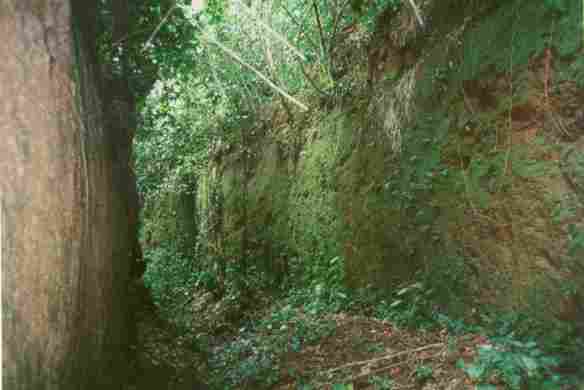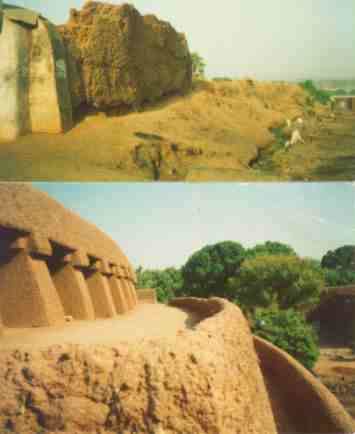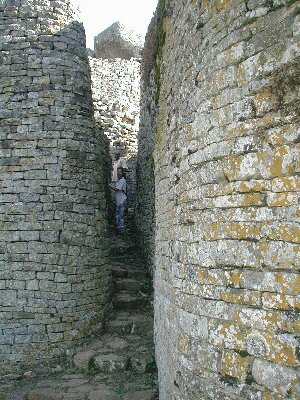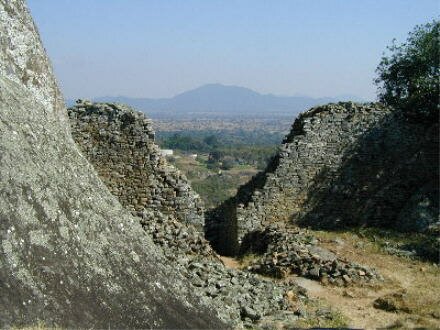


Notice: This is the official website of the All Empires History Community (Reg. 10 Feb 2002)
Sub-Saharan African architecture |
Post Reply 
|
| Author | ||
Siemowit 
Janissary 
Joined: 06-Nov-2007 Online Status: Offline Posts: 28 |
 Quote Quote  Reply Reply
 Topic: Sub-Saharan African architecture Topic: Sub-Saharan African architecturePosted: 13-Dec-2007 at 13:10 |
|
|
Does anybody know where can I find information about Sub-Saharan African architecture ?
Where can I find pictures of mosques, mud palaces etc ?
|
||
 |
||
Guests 
Guest 
|
 Quote Quote  Reply Reply
 Posted: 14-Dec-2007 at 02:00 Posted: 14-Dec-2007 at 02:00 |
|
|
Search Tombuctu but also Great Zimbabwe. Those are the better known.
There is a site about Nigerian Archaelogy that you could find interesting as well.
In this site made by scientists you can find what you are looking for:
|
||
 |
||
jdalton 
Pretorian 
Joined: 02-Aug-2007 Location: Canada Online Status: Offline Posts: 166 |
 Quote Quote  Reply Reply
 Posted: 15-Dec-2007 at 05:10 Posted: 15-Dec-2007 at 05:10 |
|
|
The most famous examples of sub-Saharan architecture (at least the ones that I know about) are probably:
Great Zimbabwe, the largest stone city built by the Shona kingdom which the modern nation of Zimbabwe is named after. When Europeans first saw it they tried to explain its existence by saying it was built by a lost nation of white people. They just couldn't accept that the ones who built it were the same people who lived all around it! The pyramids of Meroe, from Ancient Egypt's neighbour to the south, Nubia. The Nubians copied the Egyptian manner of burying their dead, but put their own spin on it- No one would be able to confuse a Nubian pyramid for an Egyptian one! Timbuktu has many buildings built in the distinctive mud-brick style of the West African Sahel, but its mosques are surely the best and most famous of this style. It takes constant repair to keep the buildings together- that's why the sides of the buildings have a wooden scaffold built right in- so workers can climb up the sides easily! Benin City, which was actually in Nigeria not Benin, sadly no longer exists. Apparently it was quite impressive in its day. The bronze plaques from the city gates were *cough*found*cough* by British explorers and brought back to be displayed in the British Museum. I've seen them in person. They're quite nice. I'm sure there must be other buildings of note as well. Swahili trading ports, for example, or buildings from the centuries upon centuries of civilization in Ethiopia and Somalia, or other relics from West Africa. But those are the ones I know about. |
||
|
Lords of Death and Life (a Mesoamerican webcomic)
|
||
 |
||
Arkhanson 
Shogun 
Joined: 04-Aug-2004 Location: Turkey Online Status: Offline Posts: 217 |
 Quote Quote  Reply Reply
 Posted: 07-Jun-2008 at 16:18 Posted: 07-Jun-2008 at 16:18 |
|
|
But mostly they used stone and mud bricks for buildings.
|
||

|
||
 |
||
Tk101 
Knight 

Joined: 18-Apr-2007 Location: United States Online Status: Offline Posts: 60 |
 Quote Quote  Reply Reply
 Posted: 15-Jun-2008 at 19:03 Posted: 15-Jun-2008 at 19:03 |
|
|
I found a site you might be interested in. Theres not too much availiable in terms of information on these civilizations. Hopefully soon some interest will drive more discoveries before whats rermains of these great civlizations disappear completely .
Here is some from Kilwa the capital of the Swahili States of East Africa
from memory they were apart of a greater trade network that links Arabia, india, africa, and china..
also if i am mistaken please correct me but wasn't it the people of Kilwa that built magnificient homes and other structures made from Coral. Didn't they also have a sophisticated Sewer system as well?
and i found this video on the swahilli civlization.
I wish they had more information.
|
||
|
there is only one truth
- Conan [IMG]http://www.architecture.org/shop/images/402036lg.jpg[IMG] |
||
 |
||
Rakasnumberone 
Shogun 
Suspended Joined: 14-Aug-2007 Online Status: Offline Posts: 211 |
 Quote Quote  Reply Reply
 Posted: 01-Jul-2008 at 18:11 Posted: 01-Jul-2008 at 18:11 |
|
|
Here's a clip about the mosque of Djenne. Very interesting.
http://www.youtube.com/watch?v=op3qQ2z3h9k&feature=related Edited by Rakasnumberone - 01-Jul-2008 at 18:12 |
||
 |
||
Bernard Woolley 
Pretorian 
Joined: 11-Jun-2008 Location: Canada Online Status: Offline Posts: 154 |
 Quote Quote  Reply Reply
 Posted: 02-Jul-2008 at 01:11 Posted: 02-Jul-2008 at 01:11 |
|
|
I remember reading that some of the buildings in Swahili cities were decorated with Chinese ceramics. Would anyone happen to have any information on this?
|
||
 |
||
Rakasnumberone 
Shogun 
Suspended Joined: 14-Aug-2007 Online Status: Offline Posts: 211 |
 Quote Quote  Reply Reply
 Posted: 02-Jul-2008 at 01:21 Posted: 02-Jul-2008 at 01:21 |
|
I don't have any links, but yes they did. Every house had a room with rows of plater worked niches built into the wall. They would place Chinese ceramics in the niches. Think of it like the same way we put our best china on display in a glass case somewhere in the house for our guests to admire. It was a status symbol because they were imported, so it was a way to show off your wealth. |
||
 |
||
andrew 
Earl 
Joined: 31-May-2007 Online Status: Offline Posts: 253 |
 Quote Quote  Reply Reply
 Posted: 04-Jul-2008 at 19:23 Posted: 04-Jul-2008 at 19:23 |
|
|
In the great city of Zimbabwe it was said goods came from India and China, via African trade routes so it goes to show that international goods were a key component of African homes.
|
||
 |
||
Rakasnumberone 
Shogun 
Suspended Joined: 14-Aug-2007 Online Status: Offline Posts: 211 |
 Quote Quote  Reply Reply
 Posted: 04-Jul-2008 at 21:26 Posted: 04-Jul-2008 at 21:26 |
|
Just goes to show that we assume so much about what life was like in the past. We assume we invented everything, but what we have now is the end product of years of knowledge. Even back then the world was much more interconnected than we realize. |
||
 |
||
Guests 
Guest 
|
 Quote Quote  Reply Reply
 Posted: 11-Jul-2008 at 03:52 Posted: 11-Jul-2008 at 03:52 |
|
|
It is interesting to note that by the time of splendor of Zimbabwe, Madagascar was already colonized by Indonesians and theirs influence was felt even in Mozanbique and other places of coastal South East Africa. So, perhaps -Just a wild theory- the Chinese ceramics was carried by Indonesian merchants all the way from Asia. It is also curious that in Indonesia of the time there was a fabulous land of gold that perhaps was located in Africa. |
||
 |
||
Ikki 
Chieftain 

Guanarteme Joined: 31-Dec-2004 Location: Spain Online Status: Offline Posts: 1378 |
 Quote Quote  Reply Reply
 Posted: 12-Jul-2008 at 17:20 Posted: 12-Jul-2008 at 17:20 |
|
Search about Ethiopia wich have great examples:
Church of Lalibela
 Obelisk of Axum

That's sure too for the "Sudan" region and western África, had an active trade with the the rest of the world since at least VIII century when arabs boomed the relations with the Mediterranean crossing the Sáhara, the empires like Ghana or Mali expanded greatly because this trade (is only one of the reasons)
|
||
 |
||
Guests 
Guest 
|
 Quote Quote  Reply Reply
 Posted: 12-Jul-2008 at 19:28 Posted: 12-Jul-2008 at 19:28 |
|
Well, Sudan and Ethiopia are so close to the Middle East through the Red Sea to have a real independent development. For me it is a lot more interesting the archeology of South Saharan Africa, as the examples below. With respect to Arab traders it is interesting to know that Indonesians settled Madagascar and traded with South East Africa since two thousand years ago, a lot before the muslim expansion.
OWU
 Sungbo's Eredo
Largest SS African monument
 Kano City walls
  And, of course, Great Zimbabwe
  |
||
 |
||
Ikki 
Chieftain 

Guanarteme Joined: 31-Dec-2004 Location: Spain Online Status: Offline Posts: 1378 |
 Quote Quote  Reply Reply
 Posted: 12-Jul-2008 at 20:27 Posted: 12-Jul-2008 at 20:27 |
|
Ethiopia is closely related to Middle East and North Africa that others subsaharan cultures with the possible exception of Niger rive's region after 1500, but at all is a native culture with a history deeply integrated with her neighbour subsaharans of East Africa so is equally valid (in fact, Siemowit only talk about subsaharan)
About "interesting", certainly Zimbabwe is very interesting because his special half independent conditions but i find equally interesting the great complexity of ethiopian work.
Be careful, muslims didn't create the trade in the western part of the Sahara only expanded it, since roman times there were contacts between the two zones (and probably since cartaghinians) althought more lightest than in other regions of Africa. The first subsaharan regions wich traded with the rest of the world was of course those of East Africa with egyptians, and then greeks, romans, nabateans... so in this sense the eastern section of the continent have advantage but i'm not sure about your statement of the indonesian traders, there were indonesian settlers in Madagascar who probably arrived there directly since the asiatic islands, and we know the contacts between Southeast Asia and Eastern Africa, but not in the hands of indonesians but in greek, arab and ethiopians hands who took their goods in India from eastern traders. Edited by Ikki - 12-Jul-2008 at 20:48 |
||
 |
||
Guests 
Guest 
|
 Quote Quote  Reply Reply
 Posted: 13-Jul-2008 at 01:37 Posted: 13-Jul-2008 at 01:37 |
|
|
Ethiopia and Northern Africa are interesting, but because theirs long interconnection with the Middle East civilizations it gaves the impression it is all what Africa has. Come on, Ethiopians still believe they had the ark of the covenant given to them by King Solomon!
I preffer to study more isolated cultures of SS Africa, as the one shown above.
Indonesian legacy in coastal South East Africa is not quite well known, but it is also interesting. Some of the things you can trace to Indonesia are bananas, the xylophones and also certain fortune-telling games. Of all of the connections, what is clear is the musical instruments influences.
I quote:
HistoryThe xylophone appeared in Southeast Asia about the 14th century. It became highly developed through use in the Indonesian gamelan, or percussion orchestra. The simplest xylophone were a pair of bars that laid across the player's legs. More complex instruments were developed that were mounted on a frame. The use of the xylophone spread throughout the continent of Africa, possibly by being imported through Madagascar. It became a prominent instrument in African music. |
||
 |
||
Post Reply 
|
| Forum Jump | Forum Permissions  You cannot post new topics in this forum You cannot reply to topics in this forum You cannot delete your posts in this forum You cannot edit your posts in this forum You cannot create polls in this forum You cannot vote in polls in this forum |
Copyright ©2001-2009 Web Wiz
This page was generated in 0.144 seconds.











 Printable Version
Printable Version Google
Google Delicious
Delicious Digg
Digg StumbleUpon
StumbleUpon Windows Live
Windows Live Yahoo Bookmarks
Yahoo Bookmarks reddit
reddit Facebook
Facebook MySpace
MySpace Newsvine
Newsvine Furl
Furl Topic Options
Topic Options